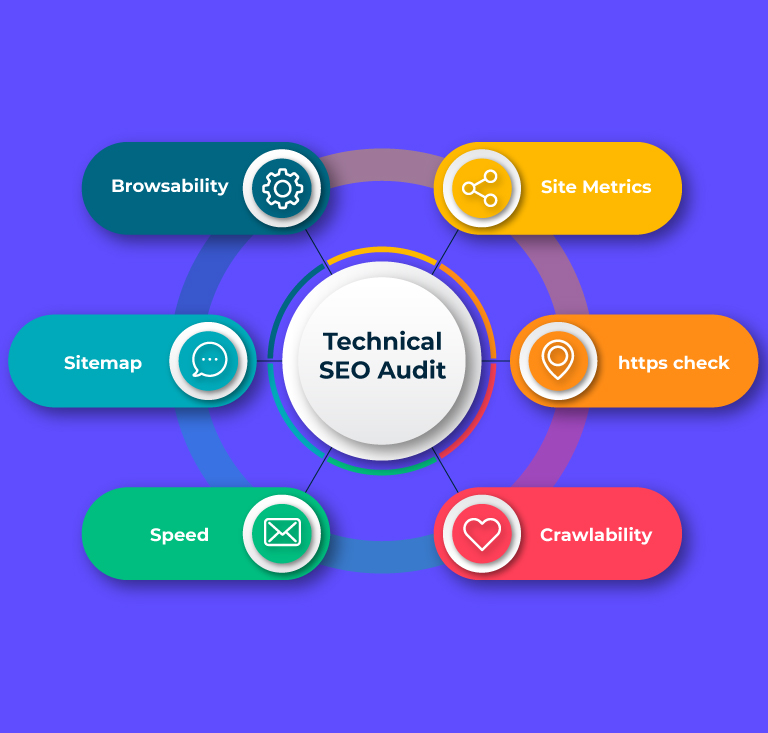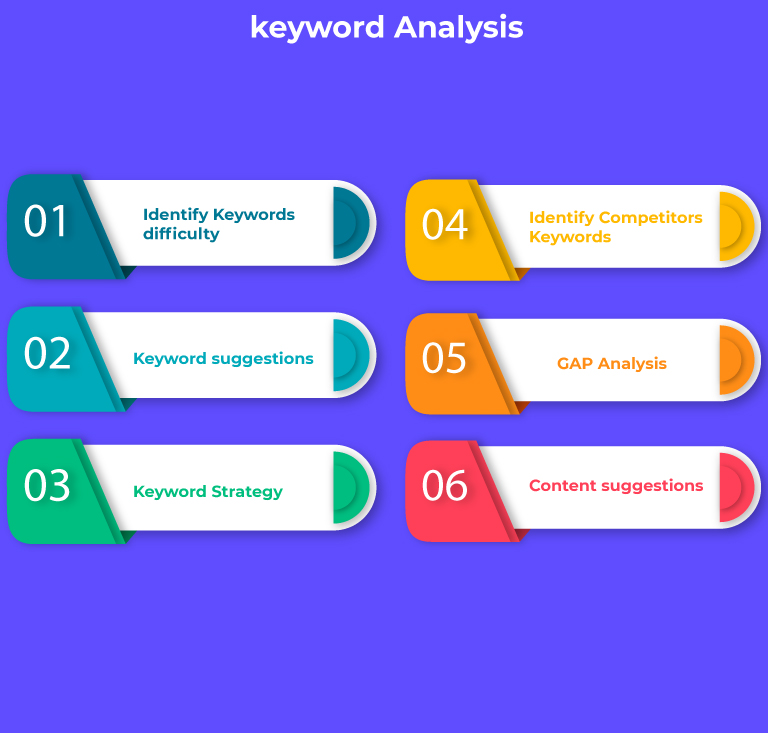Search Optimization
Search Engine Optimization
Benefits of Search Engine Optimization
Increased findability of web pages
A time tested sales process for your sales team to follow
Increases search terms on the web pages
Gets qualified leads to the web page
Multiple sources to generate traffic
Improves credibility and trust
Ranking on the first page of google boosts credibility among clients
Our Process
Technical Audit
-
- Identify page issues
- Identify Indexing and Sitemap
- Analyze speed and responsiveness
- Analyze backlinks

Keyword Strategy
- Benchmark competitors
- Identify topic buckets
- Identify keywords
- Decisions on the web pages

Off-Page Optimization
- Benchmark Competition
- Artiles and Guest blog submissions
- Forum participation
- Image and Video submission

On-Page Optimization
- Keyword checks
- Image Audit
- Title – Description – H1- H2 Audit
- Video Audit

JOIN NOW
JOIN OUR WEEKLY NEWSLETTER

FAQS.
FAQS.
Identify crawl errors, Ensure your site is mobile-friendly, Audit for keyword.,Perform a Google site search, Meta description length.,Check for site-wide duplicate content.
Crawl your website to identify issues, Review and optimize your sitemap,Improve your site speed, Do a link profile audit, Check your HTTPS content, Conduct an on-page SEO audit these are the steps should be followed in a technical seo audit
Backlink analysis is a comprehensive review of a website backlink to analyse the site performance and identify the issues that could affect its search engine ranking
Important elements of Technical SEO include crawling, indexing, rendering, and website architecture.
The purpose of the competitors analysis is to understand your competitors’ strengths and weaknesses in comparison to your own and to find a gap in the market.
A competitor analysis should include your competitors’ features, market share, pricing, marketing, differentiators, strengths, weaknesses, geography, culture and customer reviews.
The process of creating a performance maps is to analyze what motivates learners,what they need to do, and what they need to know in order to change your behavior.
Steps to Creating a Successful Site Mapping Strategy Step 1: Set Goals. Step 2: Audit Your Existing Site. Step 3: Consider Your Site’s Architecture. Step 4: Start Your Site Map.
Step 1: Make a list of important, relevant topics based on what you know about your business. Step 2: Fill those topics with keywords. Step 3: Understand How Intent Affects Keyword Research and Analyze Accordingly.Step 4: Research related search terms.
Gap analysis can help you compare your businesses or project’s actual performance as against the performance you had planned to achieve.
Keyword research should influence your website navigation, URL naming and content for each page. For main navigation titles and page names, keyword analysis will help you determine what terms people are searching for in relation to the products, services and the location of your business.
Choosing a perfect focus keyword or keyphrase is not an exact science. You should aim for a combination of words that are actually used by a search audience. Aim for a keyphrase that is relatively high in volume and one that will suit your audience.
Off-page SEO refers to anything done outside of your website with the potential to affect search engine rankings.
Directory submission is the practice where your website URL and the details on the web in a directory are submitted under a particular category. You can also improve your link building in this way.It is an off page factor which will help you to optimize your webpage.
Publishing a blog post and guest post is the same. You have to perform keyword research and start writing an article around the focus keyword. If you publish it on your own blog, then it’s termed as a blog posting. If you publish it on someone’s blog, then it’s termed as guest postin
High quality backlinks redirect (link) page visitors to a website through the use of keywords.
Identify crawl errors, Ensure your site is mobile-friendly, Audit for keyword.,Perform a Google site search, Meta description length.,Check for site-wide duplicate content.
Crawl your website to identify issues, Review and optimize your sitemap,Improve your site speed, Do a link profile audit, Check your HTTPS content, Conduct an on-page SEO audit these are the steps should be followed in a technical seo audit
Backlink analysis is a comprehensive review of a website backlink to analyse the site performance and identify the issues that could affect its search engine ranking
Important elements of Technical SEO include crawling, indexing, rendering, and website architecture.
The purpose of the competitors analysis is to understand your competitors’ strengths and weaknesses in comparison to your own and to find a gap in the market.
A competitor analysis should include your competitors’ features, market share, pricing, marketing, differentiators, strengths, weaknesses, geography, culture and customer reviews.
The process of creating a performance maps is to analyze what motivates learners,what they need to do, and what they need to know in order to change your behavior.
Steps to Creating a Successful Site Mapping Strategy Step 1: Set Goals. Step 2: Audit Your Existing Site. Step 3: Consider Your Site’s Architecture. Step 4: Start Your Site Map.
Step 1: Make a list of important, relevant topics based on what you know about your business. Step 2: Fill those topics with keywords. Step 3: Understand How Intent Affects Keyword Research and Analyze Accordingly.Step 4: Research related search terms.
Gap analysis can help you compare your businesses or project’s actual performance as against the performance you had planned to achieve.
Keyword research should influence your website navigation, URL naming and content for each page. For main navigation titles and page names, keyword analysis will help you determine what terms people are searching for in relation to the products, services and the location of your business.
Choosing a perfect focus keyword or keyphrase is not an exact science. You should aim for a combination of words that are actually used by a search audience. Aim for a keyphrase that is relatively high in volume and one that will suit your audience.
Off-page SEO refers to anything done outside of your website with the potential to affect search engine rankings.
Directory submission is the practice where your website URL and the details on the web in a directory are submitted under a particular category. You can also improve your link building in this way.It is an off page factor which will help you to optimize your webpage.
Publishing a blog post and guest post is the same. You have to perform keyword research and start writing an article around the focus keyword. If you publish it on your own blog, then it’s termed as a blog posting. If you publish it on someone’s blog, then it’s termed as guest postin
High quality backlinks redirect (link) page visitors to a website through the use of keywords.
Blogs on SEO
Read more on blogs on SEO get more insights
Top 10 Off-Page SEO Techniques:
Off-page SEO refers to the optimization activity you can perform outside of your website. Anything that happens outside of your website and increases your ranking is considered off-page SEO: social media marketing,
How to make the best of your back linking strategy:
Stat states that around 83% of B2B marketers practice social advertising second after search engines. From serving customers to influencing your industry flexibly, social spaces


